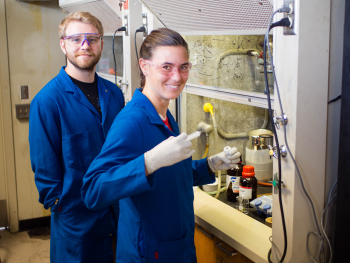
School:
Grade Level:
Teaching Position:
Supervisor:
Department:
Mentor:
Research Project Year:
Research Project Title:
Research Project Description:
Vitrimers are a new category of polymer that exhibit both the durability of a thermoset and the reprocess-ability of a thermoplastic. This is achieved using exchangeable covalent bonds within the polymer that allow it to relax stress—an effect which can be modulated in the presence of certain catalysts. The goal of our project was, first, to characterize the kinetics of acid-catalyzed bond exchange to determine if there was a relationship between the catalyst’s acidity and the activation energy of the stress relaxation. The second goal of our project is to create a vitrimer system that is driven by a light-stimulus. This can be realized with the use of a photoacid, a chemical moiety which produces an acid when irradiated with certain light of a specific wavelength.
Research Project Attachments:
| Attachment | Size |
|---|---|
| 1.6 MB |
Curriculum Project Year:
Curriculum Project Title:
Curriculum Project Description:
This is a high school level phenomena-based 5E lesson in accordance with the NGSS standards. It covers the processes of transcription and translation through the lens of sickle cell anemia. Students begin the lesson with a case study of a patient with sickle cell anemia (though the students do not know this from the start). Students view sickled blood under a microscope and compare it to healthy blood. They also model the flow of normal and sickled cells through capillaries. Next, students master the process of transcription and translation through a group activity where students are given roles with the goal of decoding a sentence (which simulates an amino acid chain) from a DNA sequence. From here, students complete a jigsaw activity wherein they become experts on a specific topic which they then teach to their group members. After the jigsaw, students will build their own normal and mutated beta globin proteins, going through the process of transcription, translation, and protein folding. The culminating activity asks students to interpret data to draw conclusions about the selective advantage of the sickle cell mutation in areas where malaria is prevalent.
https://drive.google.com/open?id=1mWRboF-h1SiUsj7bADUjU0ICD-JFJGAnCURRICULUM PROJECT RESOURCES
